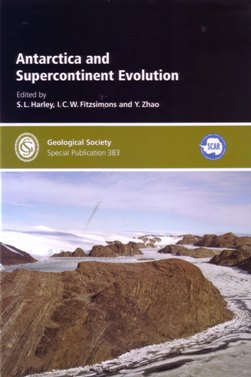 Antarctica’s geological record spans 3.5 billion years and provides a remarkable window into the geological history of the world. This book has a summary chapter followed by eight detailed chapters providing an insight into current understanding of the evolution of the continent of Antarctica, and where Antarctica may have been incorporated into the supercontinents of old. The discussion ranges across Antarctica, California, Africa, India and Australia.
Antarctica’s geological record spans 3.5 billion years and provides a remarkable window into the geological history of the world. This book has a summary chapter followed by eight detailed chapters providing an insight into current understanding of the evolution of the continent of Antarctica, and where Antarctica may have been incorporated into the supercontinents of old. The discussion ranges across Antarctica, California, Africa, India and Australia.
The introductory chapter summarises the current state of knowledge of the ancient supercontinents and how the geology of Antarctica has contributed to this knowledge. The chapter concludes with a summary of the uncertainties that remain to be resolved in time. This is mind boggling stuff.
The remaining eight papers present evidence covering geochemistry, mineralogy and tectonics and are summarised briefly below.
Chapter 2 documents the lithotectonic zones present in Rayner Province and how these are similar to features in the Albany-Fraser Orogen in Western Australia. The paper suggests these two locations evolved in similar tectonic environments followed by steady closure of the ocean that separated the Mawson Continent from Western Australia about 1300-1400Ma ago.
Chapter 3 describes how feldspar-lead isotopic information from Eastern Antarctica can be correlated with mineral compositions from the Dharwar Craton and the Eastern Ghats in India. A different mineralogy is also described in the Ruker Complex in Antarctica suggesting a different post-Archaean evolution for that region.
Chapter 4 sets out the tectonic implications drawn by examining the mineralogy (especially levels of boron and phosphorus) in the Larsemann Hills, Prydz Bay in East Antarctica. The paper then describes how these are similar to rocks near Broken Hill, Australia and how they may have been assimilated into Antarctica.
Chapter 5 describes the complex tectonothermal events evident in the rocks making up the Prince Charles Mountains of the Prydz Bay region, East Antarctica. It goes onto discuss how the assembly of the Gondwana supercontinent may have resulted from the collision of a number of cratonic blocks around 570 to 490 Ma.
Chapter 6 describes the metamorphic rocks in the central Sor Rondane Mountains, eastern Dronning Maud Land, East Antarctica, and proposes the area be a test ground for the regional tectonic processes proposed for the orogeny of Gondwana.
Chapter 7 presents information on the mineralogy of garnet-sillimanite gneisses in Eastern Antarctica and the implications of the P-T path matches on ultrahigh-temperature metamorphosis.
Chapter 8 moves to West Antarctica and discusses the differences in isotopic composition of zircons in granite found in the area. The implications for the formation of Gondwana are discussed in relation to the mechanisms and timing of crustal reworking vs crustal growth.
Chapter 9 provides additional insight into how the composition of detrital zircon in northern Victoria Land, Antarctica is evidence of a range of rock forming mechanisms ranging from contemporaneous magmatic activity to erosion of older crustal sources currently covered by the polar ice sheet.
Reviewed by James Montgomery
ANTARCTICA AND SUPERCONTINENT EVOLUTION Edited by S.L. Harley, I.C.W. Fitzsimons and Y. Zhao
Published by Geological Society, Special Publication 383, 2013. ISBN 978-1-86239-367-7, 237pp hbk.
www.geolsoc.org.uk